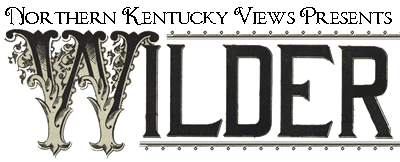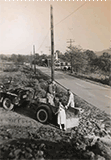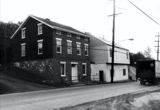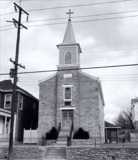
Newport's Queen City Racetrack
| On the location where the steel mill is in Wilder, it was built in 1895, and closed about ten years later. It's been described as “more of an annoyance than a true rival for Latonia.“ It did, however, run a ferry across the Licking for Kenton County patrons. |
| . . . and then there was the time 15,000 people came to the track for a buffalo hunt, knowing they were being conned, but “wanted to see how complete a humbug could be got up.” Story here. |
Here's where the Queen City Track was.
Weyman Brothers Dairy near Wilder. Note the steel mill in the background.
from a Facebook posting by Victoria Weyman
We've read that Moock Road is properly pronounced with a Moo sound, as in cows, because of all the dairy farms. True? It's a good story, and there were a lot of dairy farms - witness the above list from the 1910 Newport City Directory - one of which was owned, however, by a family named Moock. So, true? We have doubts. |
Evers Dairy Farm, Johns Hill
From a Facebook post by Robert J. Seifert
 |
 |
| Feldmann's Dairy, Licking Pike | |
Beacon Inn on Licking Pike
From a Facebook post by Dustin Hensley
 |
| Aerial View of Wilder, 1981 |
 |
| The first Drees Home is this house in Wilder. Built in 1928 by Theodore Drees, it took five years to sell. Drees earlier built homes in Brazil. |
| Drees has a history of their company on their web site. |
St. John the Baptist Roman Catholic Church & Parsonage, John's Hill
(not to be confused with an old St. John's Evangelical Church on Pooles Creek)
Rev. Paul Ryan's History of St. John's from 1954 is here.
St. John's celebrates it's jubilee in 1908.
J. Winston Coleman ran a weekly series in the Lexington Herald featuring
various Kentucky sites. On February 21, 1965, he picked St. John's. See it
here. (pdf)
St. John's is on the National Register
of Historic Places. The application (pdf) contains lots of images, history, and architectural details.

The Catholic Telegraph, May 6, 1909
![]()
 |
 |
The L & N Comes Across the Licking into Wilder, 1919
 |
 |
 |
| The L & N Railroad at the steel mill in Wilder, 1919 | L & N leaves Wilder for Newport |
|
The above set of five pictures is from a larger set, mostly from Latonia.
The rest of them can be seen
here.
![]()
| It says here that Wilder will have a population, of 3,000 | |
| The citizens of the area known as Wilder presented a petition to the Campbell County Circuit Court on February 14, 1935 asking to organize an official town. The petition was approved on March 14, 1935, and the first city council meeting was five days later. The petition was presented as “Wilders,” but by the time it was OK'd, it had been approved as “Wilder.” There was an early railroad stop in the area called Wilders Station on timetables. We've read that the town is thought to be named for an official of the railroad, James Hamlin Wilder, and we've read that it's named for a Covington ophthalmologist, who was also named James Hamlin Wilder. Same guy? | “James Shea and frank Myers, both of Covington, who had a fight according to the rules of the prize ring, on the 18th of June last, about three miles south of Newport, on the Licking turnpike, were arrested in the former city on Friday morning, and taken to Newport for trial. Myers was tried before Esquire Payne, who assessed a fine of $50 and costs against him. Shea will be tried before the same magistrate next Tuesday.” Courier-Journal, August 16, 1869 |
| 14 boxcars of free watermelons in Wilder, here. | Plane crashes in Wilder, 1945. |
![]()









